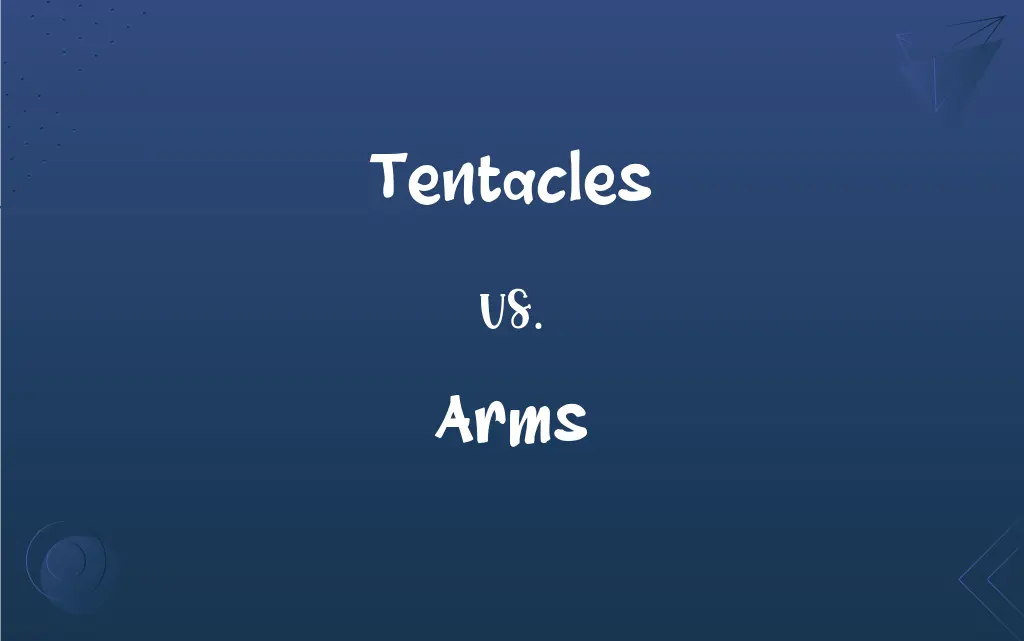Tentacles vs. Arms: What's the Difference?
Edited by Harlon Moss || By Janet White || Published on December 13, 2023
Tentacles are elongated, flexible appendages often found in marine animals for sensation or grasping, whereas arms are limb extensions in humans and some animals used for movement and manipulation.

Key Differences
Tentacles are typically slender, elongated, and flexible, found in animals like octopuses and squids, primarily used for sensing, grasping, or moving. Arms, on the other hand, are the upper limbs of humans and some animals, structured with bones and muscles, used for a wide range of motions and tasks.
The composition of tentacles varies among species; they may contain suckers, hooks, or adhesive structures, and lack skeletal support. While, arms consist of a skeletal framework, muscles, and joints, providing strength and flexibility for various activities.
Tentacles often play a vital role in feeding, mating, and sensing in their respective organisms, being highly adapted for these specific functions. However, arms are essential for daily human activities, including lifting, carrying, and manipulating objects, and are also used for non-verbal communication.
Tentacles have evolved in a diverse range of marine and some terrestrial animals, each adapting to their environment. Human arms have evolved for dexterity and strength, enabling complex tasks like tool use and construction.
In culture and literature, tentacles often symbolize mystery or alien characteristics, commonly seen in science fiction. Arms have a broad range of symbolic meanings, from strength and power to nurturing and care.
ADVERTISEMENT
Comparison Chart
Primary Function
Sensing, grasping, and movement
Movement, manipulation, strength
Anatomical Structure
Elongated, flexible, sometimes with suckers or hooks
Bone and muscle structure with joints
Found In
Mostly marine animals like octopuses, squids
Humans and various animals
Symbolism
Mystery, alien nature
Strength, power, care
Evolutionary Adaptation
Adapted for specific functions like feeding
Evolved for dexterity and complex tasks
ADVERTISEMENT
Tentacles and Arms Definitions
Tentacles
In some plants, tentacles refer to elongated structures used for trapping insects.
The carnivorous plant’s tentacles swiftly closed around the unsuspecting fly.
Arms
Arms can signify a branch or a division of an organization or field.
She worked in the research arm of the company.
Tentacles
Tentacles can be sensory organs, providing tactile or chemical information to the animal.
The jellyfish uses its tentacles to detect prey in the water.
Arms
Arms are the upper limbs of the human body, extending from the shoulder to the hand.
She raised her arms in triumph after winning the race.
Tentacles
Tentacles are slender organs containing suckers or adhesive surfaces, primarily in cephalopods.
The squid's tentacles were covered in tiny, powerful suckers.
Arms
In a military context, arms denote weapons or armaments.
The soldiers were instructed to lay down their arms.
Tentacles
In a figurative sense, tentacles represent an entity's reach or influence extending in multiple directions.
The corporation's tentacles extended into various global markets.
Arms
Arms refer to the ability to use and control one's upper limbs.
After the injury, he gradually regained the use of his arms.
Tentacles
Tentacles are flexible, elongated appendages found in some animals, used for grasping or sensing.
The octopus used its tentacles to explore the ocean floor.
Arms
Figuratively, arms imply support, embrace, or protection.
The child ran into her mother's arms for comfort.
Tentacles
An elongated flexible unsegmented extension, as one of those surrounding the mouth of a sea anemone, used for feeling, grasping, or locomotion.
Arms
An upper limb of the human body, connecting the hand and wrist to the shoulder.
Tentacles
One of these structures in a cephalopod, typically being retractile and having a clublike end usually with suckers or hooks, in contrast to an arm, which is nonretractile and typically has suckers along the underside.
Arms
A part similar to a human arm, such as the forelimb of an animal or a long part projecting from a central support in a machine.
Tentacles
(Botany) One of the sensitive hairs on the leaves of certain insectivorous plants, such as a sundew.
Tentacles
A similar part or extension, especially with respect to the ability to extend influence, activity, or control
An espionage network with far-reaching tentacles.
Tentacles
Plural of tentacle
FAQs
Do tentacles have a skeletal structure?
No, most tentacles lack a traditional skeletal structure.
What are tentacles?
Elongated, flexible appendages found in certain animals, used for sensing or grasping.
What muscles are in the arm?
Major arm muscles include the biceps, triceps, and forearm muscles.
What are arms?
Upper limbs of humans and some animals, used for movement and manipulation.
How many bones are in a human arm?
A human arm typically has 30 bones: the humerus, ulna, radius, and 27 hand bones.
Can tentacles regenerate?
Yes, in many species like octopuses, tentacles can regenerate if lost.
Can arms be prosthetically replaced?
Yes, prosthetic arms are available with varying degrees of functionality.
Do tentacles have a sense of touch?
Yes, many tentacles are highly sensitive to touch.
Why are arms important for balance?
Arms help maintain balance, especially during walking or running.
Do all octopuses have eight tentacles?
Yes, octopuses typically have eight tentacles.
What's the main function of arms?
To facilitate movement, manipulation, and various physical tasks.
Can tentacles feel pain?
It's believed that some tentacles can sense discomfort or irritation.
What's the difference between tentacles and arms?
Tentacles are flexible, elongated appendages in some animals, primarily for sensing or grasping; arms are the upper limbs in humans and animals for movement and manipulation.
Can arms be strengthened through exercise?
Yes, various exercises can increase arm strength and muscle tone.
What animals are known for their tentacles?
Cephalopods like octopuses and squids, and some jellyfish.
Are tentacles unique to marine animals?
Mostly, but some terrestrial animals and plants have tentacle-like structures.
Are tentacles common in both aquatic and terrestrial animals?
They are more common in aquatic animals.
How do arms assist in non-verbal communication?
Arms are used for gestures and expressions that convey non-verbal messages.
How are arm fractures treated?
Treatment often involves immobilization, possibly surgery, and physical therapy.
What is a common injury to the arms?
Fractures, sprains, and muscle strains are common arm injuries.
About Author
Written by
Janet WhiteJanet White has been an esteemed writer and blogger for Difference Wiki. Holding a Master's degree in Science and Medical Journalism from the prestigious Boston University, she has consistently demonstrated her expertise and passion for her field. When she's not immersed in her work, Janet relishes her time exercising, delving into a good book, and cherishing moments with friends and family.
Edited by
Harlon MossHarlon is a seasoned quality moderator and accomplished content writer for Difference Wiki. An alumnus of the prestigious University of California, he earned his degree in Computer Science. Leveraging his academic background, Harlon brings a meticulous and informed perspective to his work, ensuring content accuracy and excellence.






































































